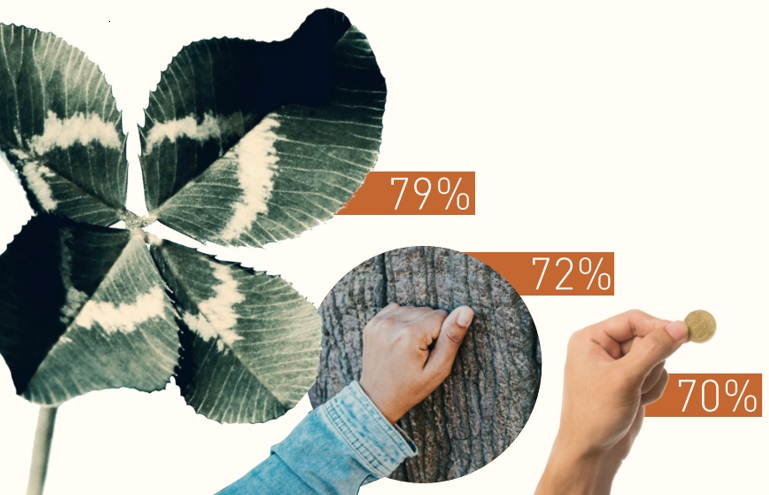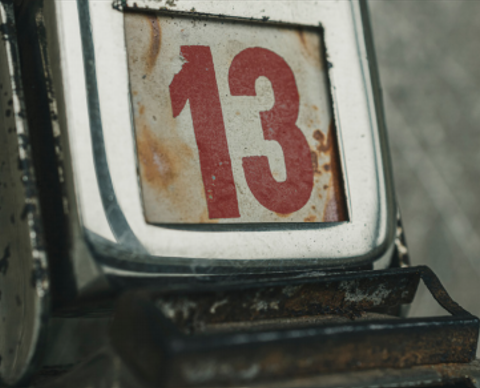
Think about the following questions.
1. In your culture, what is believed to bring good luck? Bad luck?
2. Do you follow or believe any of these superstitions?
3. Do you know any superstitions from other cultures?
VOCABULARY PREVIEW
Match each New Academic Word List(NAWL) word with the correct definition.
- likewise
- ridiculous _____
- contradictory _____
- rationality _____
- puzzling _____
- myth _____
- a. involving or having information that disagrees with other information
- b. hard to understand; confusing
- c. in the same way; also
- d. an idea that is believed by many people but that is not true
- e. very silly or unreasonable
- f. the quality of being based on facts or reason; the ability to reason
AMERICAN SUPERSTITIONS

Every culture has superstitions1. Some people believe them more than others. Our modern technological society puts a high value on rationality, but superstitions can still hold a powerful influence. Most people seem to outgrow them. But how many people continue to believe (or at least act like they believe) superstitions as adults?
A survey2 conducted3 for the journal American Demographics by the research firm Market Facts found some surprising results. In the survey, people were asked how superstitious they were. Ten common superstitions were listed. Five of them related to good luck and five to bad luck. Respondents4 were then asked to check the ones they believed and how strongly. Of the superstitions in the list, good-luck superstitions were more widely held. The top good-luck superstitions that most people believed "very much" were picking four-leaf clovers5 (seventy-nine percent), knocking on wood (seventy- two percent), picking up pennies (seventy percent), and crossing fingers for luck (fifty-nine percent). Of the bad-luck superstitions, the most common belief was that breaking a mirror brought bad luck (eighty-two percent). Other bad-luck superstitions listed in the survey included seeing black cats, walking under ladders, a groom6 seeing the bride before the wedding, and doing anything on Friday the 13th.
Even though most Americans consider superstitions nothing more than ridiculous myths, forty-four percent of the people surveyed still admitted they were superstitious. There were other seemingly contradictory results. Among the fifty-six percent who did not describe themselves as superstitious, belief in "optimistic" superstition was still fairly common. For example, twelve percent of those who said they were not really superstitious confessed7 to knocking on wood for good luck. And nine percent confessed they would pick up a penny on the street for good luck. Likewise, nine percent of "non-believers" also said they would pick a four-leaf clover for luck if they found one. And some still believed in kissing under the mistletoe8 for luck.
Of the forty-four percent of Americans who admit their superstitious beliefs, sixty-five percent said they were "only a little" superstitious. Twenty-eight percent were "somewhat" superstitious, and eight percent were "very" superstitious. Among this last group of believers, some interesting differences appeared when the men and women were considered separately. In the survey, women comprised9 sixty percent of the entire superstitious group, seeming to indicate10 that women tend to be more superstitious than men. However, more than half (sixty-four percent) of the "very" superstitious believers were male.
Additionally, there were significant differences in age between the believers and the non-believers. In the survey, more young people admitted their superstitious nature than older people. For people between the ages of eighteen and twenty-four, sixty-four percent claimed to be at least a little superstitious. But for seniors sixty-five and older, only thirty percent admitted to believing in any superstitions.
It might be expected that people with more education would be less superstitious, but results from the survey indicated almost equal numbers of believers among those with and without college degrees. Of those survey respondents whose education stopped at high school, forty-two percent reported being at least a little superstitious. For those with a college education, forty-seven percent claimed the same minimal level of belief.
These results may seem puzzling, but perhaps they are to be expected. Whether they are true believers or not, most people would say there's no harm in doing something like knocking on wood or crossing one's fingers to increase the chances of a positive outcome. After all, who couldn't use a little extra luck?
New Academic Word List
- superstition1 : n. a belief based on faith in magic or luck
- survey2 : n. an activity in which many people are asked a question or questions in order to gather information; a poll
- conduct3 : v. to plan and do
- respondent4 : n. a person who gives a response, especially as part of a survey
- clover5 : n. a small plant that usually has three leaves on each stem
- groom6 : n. a man who is about to be married or who has just married
- confess 7 : v. to admit
- mistletoe8 : n. a plant with yellowish flowers and white berries that is traditionally used as a Christmas decoration
- comprise9 : v. to make up
- indicate10 : v. to show; to suggest
READING COMPREHENSION
A ‣ Mark each statement as true (T) or false (F) according to the reading.
- The majority of the superstitions in the survey were about bad luck.
- True
- False
- The good-luck superstition followed by the most Americans relates to four-leaf clovers.
- True
- False
- Fewer than half of Americans admitted to being superstitious.
- True
- False
- More men than women described themselves as "very" superstitious.
- True
- False
- Older people were more likely to believe in superstitions.
- True
- False
B ‣ Choose the best answer according to the reading.
- What is the main purpose of the reading?
- a. To explain where some American superstitions come from
- b. To describe Americans' beliefs about certain superstitions
- c. To discuss why Americans are surprisingly superstitious
- d. To compare American superstitions with those of other countries
- In paragraph 2, the word held is closest in meaning to _____.
- a. owned
- b. kept
- c. argued
- d. believed
- Which of the following is thought to bring bad luck?
- a. A cracked mirror
- b. Crossed fingers
- c. Money on the street
- d. Walking under mistletoe
- Which good-luck tradition is most commonly followed by "non-believers"?
- a. Avoiding black cats
- b. Kissing under mistletoe
- c. Knocking on wood
- d. Picking up money
C ‣ Look for the answers in the reading and write them on the lines.
- What differences were found between men and women?
_____ - How did the beliefs of the college-educated compare with those of people without a college education?
_____
SUMMARY
Fill in the blanks with the phrases in the box.
- more often than
- in good-luck
- confessed to being
- four-leaf clovers
- superstitious beliefs
- breaking a mirror
A market-research firm conducted a survey about the 1 _____ of Americans. It was found that many Americans actually 2 _____ at least somewhat superstitious. Most of them are "optimistically superstitious," meaning they believe more 3 _____ than bad-luck superstitions. Some common and good-luck superstitions in the survey included picking 4 _____ and knocking on wood. Bad-luck superstitions on the survey included seeing a black cat and 5 _____. Of the people who responded to the survey, young people said they were superstitious 6 _____ older people did.
VOCABULARY PRACTICE
Fill in the blanks with the words in the box. Change the form if necessary.
- likewise
- puzzling
- rationality
- myth
- contradictory
- ridiculous
- It's _____ that the plant died, since it received plenty of water and sunshine.
- The results of the two studies were _____ ; one showed that the drug worked and the other that it had no effect.
- The right side of the brain is often linked to emotion and creativity, while the left side is linked to logic and _____ .
- The plot of the action movie was so _____ that I had to laugh.
- People who care about their health usually eat better; _____ ,they exercise more.
- It is a(n) _____ that the color red makes bulls angry since, in fact, bulls cannot see colors.
SUPPLEMENTAL READING
Scared of Friday the 13th

The year 2015 was a very bad one for people who believe that Friday the 13th is an especially unlucky day. In 2015, three months had a Friday that fell on the 13th of the month - February, March, and November. That is actually the most times that the 13th can possibly fall on a Friday.
The belief that Friday and the number thirteen are both unlucky possibly goes back to the time of Jesus's death. At the Last Supper, Jesus gathered his twelve followers for a special meal, but including himself, there were a total of thirteen people at the table. One of those followers later betrayed Jesus and turned him over to be killed-on a Friday. Today, superstitions about the number thirteen continue to worry people. As a result, most American skyscrapers do not have a 13th floor, and many airplanes lack a 13th row. When the number is combined with unlucky Friday, some people get doubly nervous.
When asked, only thirteen percent of Americans admit they believe that Friday the 13th is an unlucky day, but the percentage is much higher among young people. About thirty percent of Americans between the ages of eighteen and twenty-four say they generally try to be a little more careful on a Friday falling on the 13th. In Britain, a quarter of survey respondents said they make changes to their normal routine on that day. One in ten said they avoid travel, and one in twenty refuse to leave their homes!
Fill in the blanks with information from the reading.
- In one year, the 13th can be a Friday no more than _____ times.
- The number thirteen might be seen as unlucky because there were _____ at the table at the Last Supper.
- One out of ten British people reports that they _____ on Friday the 13th.

Leave a comment
Load more